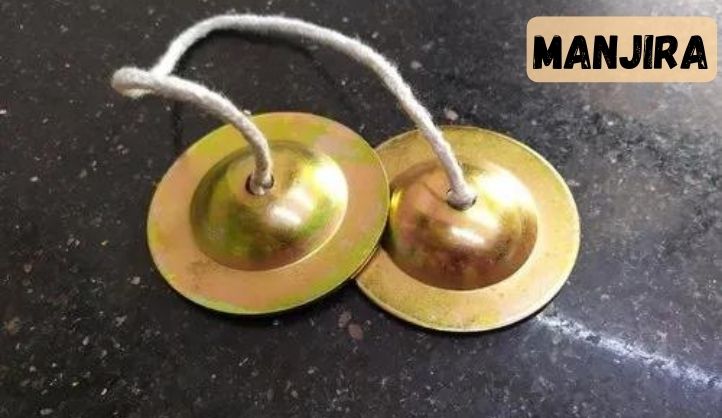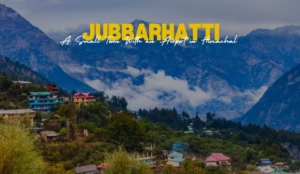In the rich cultural tapestry of Uttarakhand, the melodic sounds of traditional instruments echo through the valleys and mountains, captivating the hearts of listeners. Among these instruments, the Manjira holds a special place for its musicality, cultural significance, and historical roots.
Historical Origins
The Manjira, also known as Jalra, is a small pair of hand cymbals that have been an integral part of folk and classical music traditions in Uttarakhand for centuries. Its origins can be traced back to ancient times when it found its place in religious rituals, festive celebrations, and folk performances. Made typically from brass or bronze, these cymbals are crafted with intricate designs, often featuring auspicious symbols and motifs.
Musical Characteristics
The Manjira produces a distinctive tinkling sound that enhances the rhythm and melody of traditional music. It is played by striking the cymbals together in a rhythmic pattern, creating a bright, metallic resonance that complements vocal and instrumental performances. In folk music, it often accompanies singing and dancing, adding a lively and energetic dimension to the cultural expressions of Uttarakhand.
Cultural Significance
Beyond its musical role, the Manjira holds deep cultural significance in Uttarakhand. It is closely associated with religious ceremonies, where its rhythmic beats are believed to invoke spiritual blessings and divine presence. During festivals like Holi, Diwali, and local fairs, the Manjira’s lively tunes uplift the festive atmosphere, encouraging community participation and traditional revelry.
Some Other Traditional Instruments of Uttarakhand
Uttarakhand, renowned for its cultural diversity and rich heritage, boasts a variety of traditional instruments that are integral to its folk and classical music traditions.
Damru
The Damru is a small two-headed drum that resembles an hourglass in shape. It is traditionally associated with Lord Shiva and is played during devotional music and rituals.
Dhol
The Dhol is a large barrel-shaped drum with two heads, played with sticks or hands. It is prominently used in folk music and dance performances across Uttarakhand.
Ransingha
The Ransingha is a unique trumpet-like instrument made from a buffalo horn. It is used by the indigenous communities of Uttarakhand during religious ceremonies and festivals.
Mas hakbeen
The Mashakbeen is a traditional string instrument similar to a snake charmer’s flute. It is played by the Gadhwali and Kumaoni communities and holds a significant place in their musical traditions.
Bansuri
The Bansuri is a bamboo flute widely used in Indian classical music as well as folk music traditions in Uttarakhand. It produces melodious tones and is played during both devotional and secular music performances.
Chimta
The Chimta is a pair of tongs with metal jingles attached to one of its sides. It is used as a percussion instrument in folk music and dance performances, creating rhythmic accompaniment.
Dholki
The Dholki is a smaller version of the Dhol, often played with hands. It is popular in folk music and is used to provide rhythmic support in singing and dancing.
Conclusion
The Manjira stands as a testament to the enduring cultural heritage of Uttarakhand. Through its rhythmic beats and melodious chimes, it connects generations, preserves traditions, and celebrates the region’s vibrant spirit. As Uttarakhand evolves, the Manjira remains a timeless symbol of musical expression and cultural identity, echoing through the hills and valleys, enchanting all who hear its sweet and resonant sound.
FAQs about Manjira
1. What is a Manjira?
The Manjira, also known as Jalra, is a traditional Indian percussion instrument consisting of a pair of small hand cymbals. It is widely used in folk and classical music traditions, particularly in the cultural practices of Uttarakhand.
2. How is the Manjira played?
The Manjira is played by holding one cymbal in each hand and striking them together in a rhythmic pattern. This produces a bright, tinkling sound that complements vocal and instrumental music. Sometimes, it is also played by gently shaking the cymbals in time with the music.
3. What materials are Manjira made from?
Manjira cymbals are typically made from brass or bronze. They are crafted with intricate designs and often feature decorative patterns, auspicious symbols, or motifs that reflect the cultural heritage of Uttarakhand.
4. What role does the Manjira play in Uttarakhand’s culture?
The Manjira holds significant cultural importance in Uttarakhand. It is used in religious ceremonies, festive celebrations, and folk performances. Its rhythmic beats are believed to invoke blessings and create a joyful atmosphere during festivals and community gatherings.
5. Are there different styles of playing the Manjira?
Yes, there are various styles and techniques used to play the Manjira. These include different rhythms, patterns, and accompanying movements that enhance the musicality and cultural expressions associated with the instrument.





